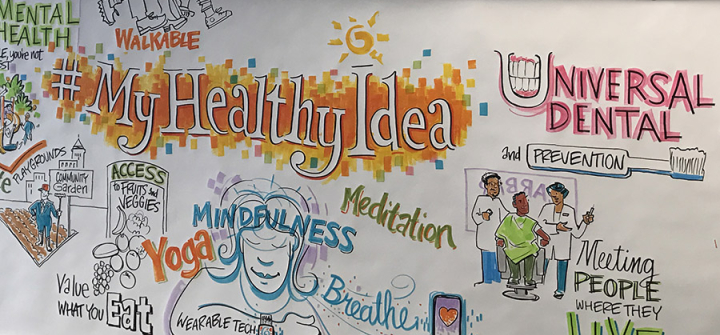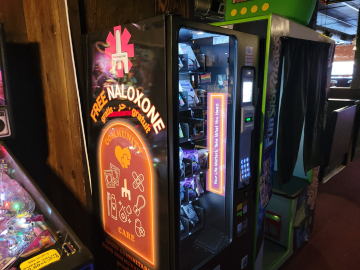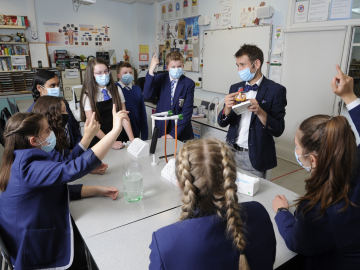5 Takeaways from Health Lab @ Light City
BALTIMORE, MD—Kicking off the Light City festival of art, music and innovation this week, Health Lab revealed the outsize role technology is poised to play in health—and the work ahead to expand access.
The day-long speaker series, produced by Baltimore Office of Promotion & The Arts and sponsored by Kaiser Permanente, explored emerging technologies and innovative practices with the potential to improve quality of life and health outcomes for everyone—in Baltimore and beyond. Here are a few things we learned:
1. THE FUTURE IS HERE, AND WE’RE NOT READY FOR IT.
Siddhartha Mukherjee, MD, DPhil, author of “The Gene: An Intimate History,” posed uncomfortable questions about the ethics of genetic diagnostic testing, a field marked by technological growth that outpaces efforts to create a code of ethics.
“How scary is it that with a panel of genetic information, we could pick and choose traits?” panelists Luis Diaz, MD, a Hopkins professor of oncology and Jeffery Kahn, PhD, MPH, director of the Berman Institute of Bioethics, asked in “The Future is Here.” Gene therapy, they argue, should focus first and foremost on the cure and prevention of disease among living people.
2. TECHNOLOGY IS CREATING A HYPER-EVOLUTION—FOR THOSE WHO CAN AFFORD IT
With implants and interventions, technology is advancing our bodies in a sort of hyper-evolution.
Param Shah, co-founder of medical device company Fusiform, addressed how 3D printing of surgical implants and prosthetics is transforming the market, making cheaper, more accessible products possible. Gymama Slaughter, PhD, discussed the “body as battery” with the potential to self-power electronic wearables like pacemakers and glucose monitors. Jon Krakauer, MA, MD of the JHU Brain, Learning, Animation & Movement Lab described the intersection of art, nature, and technology in a project called Smarts II, which enables stroke victims to use a robotic arm to interact with a digitally-simulated dolphin to rebuild coordination.
None of these technologies come cheaply, however, which lead to the refrain of the day:
3. “YOUR ZIPCODE MATTERS MORE THAN YOUR GENETIC CODE.”
Jandel Allen-Davis, VP of Government and External Relations for Kaiser Permanente made that point in her live spoken-word performance that pegged accessibility as a critical issue in health care.
“Health is not the absence of illness,” she says, “it’s the means to have the opportunity to live our best life.” But what if your neighborhood is so violent you can’t walk down the sidewalk and your corner store is stocked with liquor and chips instead of milk and vegetables?
Baltimore Police Commissioner Kevin Davis and Health Commissioner Leana Wen, MD, discussed the needed shift in policing vulnerable communities. Citing the cycle of violence and addiction perpetuated by outdated zero-tolerance and incarceration practices, Davis and Wen see policing as intervention, not enforcement. Addressing addiction, they say, could mean breaking this cycle to help battered communities heal.
In the same vein:
4. ANTIBIOTICS : INFECTIONS :: TECHNOLOGY : SOCIOECONOMIC HEALTH DISPARITY
Panagis Galiatsatos, MD, MHS, co-founder of “Medicine for Greater Good” (MGG), envisions technology as the antidote to socioeconomic health disparities. MGG requires medical residents to participate in Baltimore community service projects that address health inequities such as technology, education and policy.
Galiatsatos’s co-presenter, Sonia Lawson, PhD, OTR/L explained how consumer eHealth tools, such as portals for electronic health records, health kiosks, and text message reminders for medications and appointments, could prove key to reaching underserved areas.
And finally:
5. PLAY THE LONG GAME—IMPACT FROM INCREMENTAL CHANGES AT THE LOCAL LEVEL
From genomics to wearables and policy to practice, the future of health care lies in the hands of community changemakers embracing technology to pioneer straightforward solutions. The caveats: these solutions require grassroot-level incremental changes and a passionate long view.
For a full list of speakers and more information, please visit http://lightcity.org/labs-at-light-city/health-lab/
For more information about Light City, please visit http://lightcity.org/
Join the thousands of subscribers who rely on Global Health NOW summaries and exclusive articles for the latest public health news. Sign up for our free weekday enewsletter, and please share the link with friends and colleagues: Subscribe to GHN
An on-site artist developed this mural live as people tweeted ideas at Baltimore's Health Lab/Light City on April 3, 2017. Image/Marisa Russell





